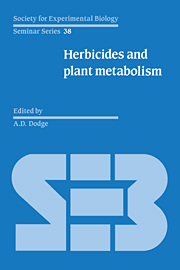Book contents
- Frontmatter
- Contents
- Contributors
- Preface
- Herbicide use and invention
- Herbicides interacting with photosystem II
- Herbicides interacting with photosystem I
- Carotenoids and chlorophylls: herbicidal inhibition of pigment biosynthesis
- Herbicides inhibiting lipid synthesis
- The shikimate pathway as a target for herbicides
- Herbicides that inhibit the biosynthesis of branched chain amino acids
- Glutamine synthetase and its inhibition
- Metabolism of herbicides – detoxification as a basis of selectivity
- Bioactivated herbicides
- Mechanisms involved in the evolution of herbicide resistance in weeds
- Conferring herbicide resistance on susceptible crops
- Herbicide glossary
- Herbicide index
- General index
Conferring herbicide resistance on susceptible crops
Published online by Cambridge University Press: 04 August 2010
- Frontmatter
- Contents
- Contributors
- Preface
- Herbicide use and invention
- Herbicides interacting with photosystem II
- Herbicides interacting with photosystem I
- Carotenoids and chlorophylls: herbicidal inhibition of pigment biosynthesis
- Herbicides inhibiting lipid synthesis
- The shikimate pathway as a target for herbicides
- Herbicides that inhibit the biosynthesis of branched chain amino acids
- Glutamine synthetase and its inhibition
- Metabolism of herbicides – detoxification as a basis of selectivity
- Bioactivated herbicides
- Mechanisms involved in the evolution of herbicide resistance in weeds
- Conferring herbicide resistance on susceptible crops
- Herbicide glossary
- Herbicide index
- General index
Summary
Introduction
The chemical industry is continually finding it harder and far more expensive to develop new selective herbicides. Conversely, there are already many herbicides in existence with excellent spectra of weed control which would be useful in a given crop, except for a minor problem; they also kill the crop. The chemical industries biorational approach to this problem is to study the herbicide degrading enzymatic pathways specific to that crop. The herbicidal moiety could then be modified by adding a chemical group that will be recognised by those enzymes, thus aiding in the herbicide degradation by the crop. Another biorational approach is to make current herbicides more effective by adding synergists that either prevent their breakdown, or prevent detoxification of toxic products in some weeds (cf. Gressel & Shaaltiel, 1988).
The approach taken by the biotechnologists in industry and the public sector is diametrically opposed to that of the chemist: to make crops genetically and biochemically amenable to herbicides by conferring resistance. There are vast differences in the levels of sophistication of the biotechnologies involved. The biotechnological approaches have the advantage of often dealing with time-tested herbicides with well elucidated weed control properties and toxicology. Registration requirements can be rather simple if it can be shown that the metabolites and residues of the herbicide match those found in crops where the herbicide is already used. Where this is not the case, more extensive research provisions might be required.
- Type
- Chapter
- Information
- Herbicides and Plant Metabolism , pp. 237 - 260Publisher: Cambridge University PressPrint publication year: 1990

